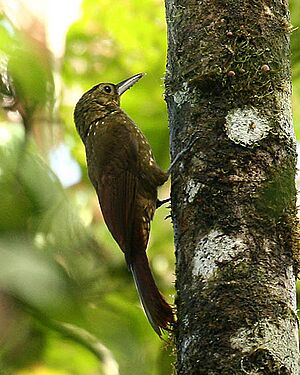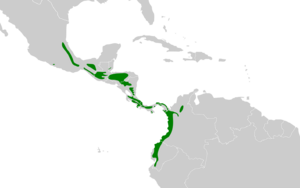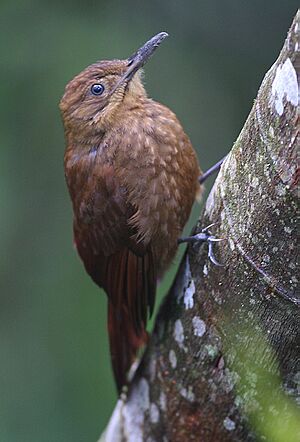Spotted woodcreeper facts for kids
Quick facts for kids Spotted woodcreeper |
|
|---|---|
 |
|
| Scientific classification | |
| Genus: |
Xiphorhynchus
|
| Species: |
erythropygius
|
 |
|
The spotted woodcreeper (Xiphorhynchus erythropygius) is a type of bird. It belongs to the ovenbird family called Furnariidae. You can find this bird in many countries. These include Belize, Colombia, Costa Rica, Ecuador, El Salvador, Guatemala, Honduras, Mexico, Nicaragua, and Panama.
Contents
About the Spotted Woodcreeper
Scientists who study birds group them into different types. The spotted woodcreeper was once thought to be the same as the olive-backed woodcreeper. However, since the mid-1900s, they have been seen as separate species.
Different bird experts have slightly different ideas about how to classify the spotted woodcreeper. Most groups, like the American Ornithological Society, agree on five main types, called subspecies. These subspecies are sometimes put into two larger groups.
- The "Spotted" Group
- X. e. erythropygius
- X. e. parvus
- The "Berlepsch's" Group
- X. e. punctigula
- X. e. insolitus
- X. e. aequatorialis
However, another group, BirdLife International, sees these two groups as completely separate species. They call them the "northern spotted woodcreeper" and the "southern spotted woodcreeper." For this article, we will follow the idea that there are five subspecies.
What Does It Look Like?
The spotted woodcreeper is a medium-sized bird. It is about 19 to 24 centimeters (7.5 to 9.4 inches) long. Males usually weigh 40 to 54 grams (1.4 to 1.9 ounces). Females weigh a bit less, about 40 to 46 grams (1.4 to 1.6 ounces).
This bird has a bill that is a bit long and curves downward. Both male and female birds look the same. Their faces have dark areas near their eyes. They also have a light, creamy stripe above their eyes.
Their head and neck are dark olive or brownish. They have small, light spots there. Their back and wing feathers are brownish with light spots and streaks. Their tail and some wing feathers are a reddish-brown color.
Their throat is light-colored with thin dark lines. Their belly is a light greenish-olive. It has large, light, tear-shaped spots. Their eyes are dark brown. Their bill is dark on top and lighter underneath. Their legs and feet are gray or greenish-gray. Young birds look similar to adults but are a bit browner.
The different subspecies have small differences in their looks:
- X. e. parvus is smaller and has more reddish-brown upper parts.
- X. e. punctigula is smaller and more greenish. It has fine streaks on its forehead and fewer spots on its belly.
- X. e. insolitus is like punctigula but has slightly darker upper parts.
- X. e. aequatorialis is smaller and more greenish. It has a lighter eye-ring and larger spots on its belly.
Where Does It Live?
The spotted woodcreeper lives in humid forests. It prefers tropical evergreen forests at lower elevations. At higher elevations, it likes evergreen mountain forests and cloud forests. In some northern areas, it lives in pine and pine-oak woodlands.
This bird likes forests with lots of moss and plants growing on trees (called epiphytes). In old forests, it usually stays high up in the trees. However, it can also be found at the edge of forests. Sometimes it lives in older forests that have grown back. You might even see it in tree plantations or near scattered trees close to a forest.
It mostly lives at elevations between 600 and 1800 meters (2,000 to 5,900 feet). In some places, it can be found as high as 2900 meters (9,500 feet). Occasionally, in Costa Rica, Colombia, and Ecuador, it lives closer to sea level.
The different subspecies are found in specific areas:
- X. e. erythropygius lives in central and southern Mexico.
- X. e. parvus is found from southern Mexico to Guatemala, El Salvador, Honduras, and Nicaragua. It is also in southern Belize.
- X. e. punctigula lives from southeastern Nicaragua through Costa Rica into central Panama.
- X. e. insolitus is found in parts of central Panama and Colombia.
- X. e. aequatorialis lives along the Pacific coast from western Colombia to southwestern Ecuador.
Behavior and Life Cycle
Movement
The spotted woodcreeper stays in the same area all year round. It does not migrate.
What Does It Eat?
This bird mainly eats small insects and other creatures with many legs (like spiders). It also eats small amounts of tiny animals with backbones and some plant material. It usually looks for food alone. Sometimes it forages in pairs or even in family groups.
It often joins groups of different bird species that are feeding together. It climbs up tree trunks and along branches, often in a spiral pattern. It finds most of its food by picking things off bark. It also probes into tangled vines, dead leaves, and plants like bromeliads. Sometimes it peels off bark to find food. It might also follow swarms of army ants to catch insects that are trying to escape.
Reproduction
Scientists do not know much about the breeding seasons for some of the subspecies. In Costa Rica and Panama, these birds nest between March and June. In Colombia, they nest from at least February to May.
The spotted woodcreeper builds its nest in a hole inside a tree or a tree stump. They usually lay two eggs. We do not know how long the eggs take to hatch. We also do not know how long it takes for the young birds to leave the nest. Details about how the parents care for their young are also not known.
How Does It Sound?
The spotted woodcreeper is quite a noisy bird. It sings mostly at dawn and dusk. It sings less often during the day. Its song is a series of 2 to 5 long, whistling sounds. Each whistle gets lower in pitch. The song lasts about 4 to 6.5 seconds. Sometimes it adds one or two more notes at the same pitch.
People have described its song in different ways, like "piiiiiiiiiiiiir, piiiiiiiiiiir, piiiiiiiiiiiir" or "d’ddrrear, d’ddrrear, d’ddrrear, whew, whew." It also has calls like a whistled "wheeeoo" or a low, hen-like "cut-uck."
Conservation Status
The International Union for Conservation of Nature (IUCN) evaluates the "northern" and "southern" spotted woodcreepers separately. Both types are listed as "Least Concern." This means they are not currently in danger of disappearing.
The exact number of these birds is not known. However, their populations are thought to be decreasing. No immediate threats have been found for either type. The spotted woodcreeper is considered uncommon to fairly common in most places. It needs continuous forest areas to live. This means it can be sensitive to forests being cut down or broken up by human activity.


